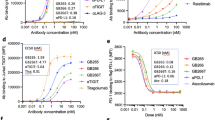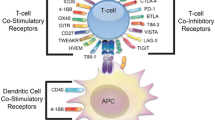Abstract
Immune checkpoint inhibitors (ICIs) have emerged as promising therapies for the treatment of cancer. However, existing ICIs, namely PD-(L)1 and CTLA-4 inhibitors, generate durable responses only in a subset of patients. TIGIT is a co-inhibitory receptor and member of the DNAM-1 family of immune modulating proteins. We evaluated the prevalence of TIGIT and its cognate ligand, PVR (CD155), in human cancers by assessing their expression in a large set of solid tumors. TIGIT is expressed on CD4+ and CD8+ TILs and is upregulated in tumors compared to normal tissues. PVR is expressed on tumor cells and tumor-associated macrophages from multiple solid tumors. We explored the therapeutic potential of targeting TIGIT by generating COM902, a fully human anti-TIGIT hinge-stabilized IgG4 monoclonal antibody that binds specifically to human, cynomolgus monkey, and mouse TIGIT, and disrupts the binding of TIGIT with PVR. COM902, either alone or in combination with a PVRIG (COM701) or PD-1 inhibitor, enhances antigen-specific human T cell responses in-vitro. In-vivo, a mouse chimeric version of COM902 in combination with an anti-PVRIG or anti-PD-L1 antibody inhibited tumor growth and increased survival in two syngeneic mouse tumor models. In summary, COM902 enhances anti-tumor immune responses and is a promising candidate for the treatment of advanced malignancies.








Similar content being viewed by others
References
Sharma P, Hu-Lieskovan S, Wargo JA, Ribas A (2017) Primary, adaptive, and acquired resistance to cancer immunotherapy. Cell 168:707–723. https://doi.org/10.1016/j.cell.2017.01.017
Whelan S, Ophir E, Kotturi MF et al (2019) PVRIG and PVRL2 are induced in cancer and inhibit CD8 + T-cell function. Cancer Immunol Res 7:257–268. https://doi.org/10.1158/2326-6066.CIR-18-0442
Stanietsky N, Simic H, Arapovic J et al (2009) The interaction of TIGIT with PVR and PVRL2 inhibits human NK cell cytotoxicity. Proc Natl Acad Sci USA 106:17858–17863. https://doi.org/10.1073/pnas.0903474106
Yu X, Harden K, Gonzalez LC et al (2009) The surface protein TIGIT suppresses T cell activation by promoting the generation of mature immunoregulatory dendritic cells. Nat Immunol 10:48–57. https://doi.org/10.1038/ni.1674
Shibuya A, Campbell D, Hannum C et al (1996) DNAM-1, a novel adhesion molecule involved in the cytolytic function of T lymphocytes. Immunity 4:573–581. https://doi.org/10.1016/S1074-7613(00)70060-4
Shibuya K, Lanier LL, Phillips JH et al (1999) Physical and functional association of LFA-1 with DNAM-1 adhesion molecule. Immunity 11:615–623. https://doi.org/10.1016/S1074-7613(00)80136-3
Chiang EY, de Almeida PE, de Almeida Nagata DE et al (2020) CD96 functions as a co-stimulatory receptor to enhance CD8+ T cell activation and effector responses. Eur J Immunol 50:891–902. https://doi.org/10.1002/eji.201948405
Zhu Y, Paniccia A, Schulick AC et al (2016) Identification of CD112R as a novel checkpoint for human T cells. J Exp Med 213:167–176. https://doi.org/10.1084/jem.20150785
Vaena D, Patnaik A, Hamilton E et al (2019) Abstract CT168: Phase I study of COM701 (a novel checkpoint inhibitor of PVRIG) in patients with advanced solid tumors. Cancer Res. https://doi.org/10.1158/1538-7445.AM2019-CT168
Johnston RJ, Comps-Agrar L, Hackney J et al (2014) The immunoreceptor TIGIT regulates antitumor and antiviral CD8 + T cell effector function. Cancer Cell 26:923–937. https://doi.org/10.1016/j.ccell.2014.10.018
Chauvin J, Pagliano O, Fourcade J et al (2015) TIGIT and PD-1 impair tumor antigen–specific CD8+ T cells in melanoma patients. J Clin Invest 125:2046–2058. https://doi.org/10.1172/JCI80445
Harjunpää H, Guillerey C (2020) TIGIT as an emerging immune checkpoint. Clin Exp Immunol 200:108–119. https://doi.org/10.1111/cei.13407
Alteber Z, Kotturi MF, Whelan S et al (2021) Therapeutic targeting of checkpoint receptors within the DNAM-1 axis. Cancer Discov, Accepted
Golan T, Bauer TM, Golan T, et al (2018) Phase 1 dose‐finding study of the anti–TIGIT antibody MK‐7684 as monotherapy and in combination with pembrolizumab in patients with advanced solid. 33rd annual meeting and pre-conference programs of the society for immunotherapy of cancer (SITC 2018). J Immunother Cancer (SITC 2018). J Immunother Cancer 6:115 Abstract O25
Sharma S, Ulahannan S, Mettu NB, et al (2018) Initial results from a phase 1a/b study of Etigilimab (OMP-313M32), an anti-T cell immunoreceptor with Ig and ITIM domains (TIGIT) antibody in advanced solid tumours. 33rd annual meeting and pre-conference programs of the society for immunotherapy of cancer (SITC 2018). J Immunother Cancer 6(Suppl 1) Abstract P289
Bendell JC, Bedard P, Bang Y-J et al (2020) Phase Ia/Ib dose-escalation study of the anti-TIGIT antibody tiragolumab as a single agent and in combination with atezolizumab in patients with advanced solid tumors. Cancer Res. https://doi.org/10.1158/1538-7445.AM2020-CT302
Rodriguez-Abreu D, Johnson ML, Hussein MA et al (2020) Primary analysis of a randomized, double-blind, phase II study of the anti-TIGIT antibody tiragolumab (tira) plus atezolizumab (atezo) versus placebo plus atezo as first-line (1L) treatment in patients with PD-L1-selected NSCLC (CITYSCAPE). J Clin Oncol 38:9503–9503. https://doi.org/10.1200/jco.2020.38.15_suppl.9503
Finnefrock AC, Fu T-M, Freed DC, et al (2012) PD-1 Binding Proteins. U.S. Patent No. 8,168,757
Murter B, Pan X, Ophir E et al (2019) Mouse PVRIg has CD8 + T cell-specific coinhibitory functions and dampens antitumor immunity. Cancer Immunol Res 7:244–256. https://doi.org/10.1158/2326-6066.CIR-18-0460
Savas P, Virassamy B, Ye C et al (2018) Single-cell profiling of breast cancer T cells reveals a tissue-resident memory subset associated with improved prognosis. Nat Med 24:986–993. https://doi.org/10.1038/s41591-018-0078-7
Sun Y, Luo J, Chen Y et al (2020) Combined evaluation of the expression status of CD155 and TIGIT plays an important role in the prognosis of LUAD (lung adenocarcinoma). Int Immunopharmacol 80:106198. https://doi.org/10.1016/j.intimp.2020.106198
Liu W, Putnam AL, Xu-yu Z et al (2006) CD127 expression inversely correlates with FoxP3 and suppressive function of human CD4+ T reg cells. J Exp Med 203:1701–1711. https://doi.org/10.1084/jem.20060772
Farhood B, Najafi M, Mortezaee K (2019) CD8 + cytotoxic T lymphocytes in cancer immunotherapy: a review. J Cell Physiol 234:8509–8521. https://doi.org/10.1002/jcp.27782
Miller BC, Sen DR, Al AR et al (2019) Subsets of exhausted CD8+ T cells differentially mediate tumor control and respond to checkpoint blockade. Nat Immunol 20:326–336. https://doi.org/10.1038/s41590-019-0312-6
Schietinger A, Philip M, Krisnawan VE et al (2016) Tumor-specific T cell dysfunction is a dynamic antigen-driven differentiation program initiated article tumor-specific T cell dysfunction is a dynamic antigen-driven differentiation program initiated early during tumorigenesis. Immunity 45:389–401. https://doi.org/10.1016/j.immuni.2016.07.011
Philip M, Schietinger A (2019) ScienceDirect heterogeneity and fate choice: T cell exhaustion in cancer and chronic infections. Curr Opin Immunol 58:98–103. https://doi.org/10.1016/j.coi.2019.04.014
Speiser DE, Ho P, Verdeil G (2016) Regulatory circuits of T cell function in cancer. Nat Rev Immunol 16:599–611. https://doi.org/10.1038/nri.2016.80
Yost KE, Satpathy AT, Wells DK et al (2019) Clonal replacement of tumor-specific T cells following PD-1 blockade. Nat Med 25:1251–1259. https://doi.org/10.1038/s41591-019-0522-3
Fourcade J, Sun Z, Chauvin JM et al (2018) CD226 opposes TIGIT to disrupt Tregs in melanoma. JCI insight 3:1–13. https://doi.org/10.1172/jci.insight.121157
Nishiwada S, Sho M, Yasuda S et al (2015) Clinical significance of CD155 expression in human pancreatic cancer. Anticancer Res 35:2287–2297
Stamm H, Oliveira-ferrer L, Grossjohann E et al (2019) Targeting the TIGIT-PVR immune checkpoint axis as novel therapeutic option in breast cancer. Oncoimmunology 8:e1674605. https://doi.org/10.1080/2162402X.2019.1674605
Leipold D, Prabhu S (2019) Pharmacokinetic and pharmacodynamic considerations in the design of therapeutic antibodies. Clin Transl Sci 12:130–139. https://doi.org/10.1111/cts.12597
Kurtulus S, Sakuishi K, Ngiow S et al (2015) TIGIT predominantly regulates the immune response via regulatory T cells. J Clin Invest 1:1–10. https://doi.org/10.1172/JCI81187DS1
Chihara N, Madi A, Kondo T et al (2018) Induction and transcriptional regulation of the co-inhibitory gene module in T cells. Nature 558:454–459
Han JH, Cai M, Grein J et al (2020) Effective anti-tumor response by TIGIT blockade associated with FcγR engagement and myeloid cell activation. Front Immunol 11:1–14. https://doi.org/10.3389/fimmu.2020.573405
Nimmerjahn F, Ravetch JV (2008) Fcγ receptors as regulators of immune responses. Nat Rev Immunol 8:34–47. https://doi.org/10.1038/nri2206
Acknowledgement
KH, SK, KL, SW, SQ, HYC, AD, MT, PW, DB, LL, EO, ZA, GC, MG, MF, MW, JH, SL and MK received salary from Compugen Ltd at the time of this study.
Author information
Authors and Affiliations
Corresponding author
Additional information
Publisher's Note
Springer Nature remains neutral with regard to jurisdictional claims in published maps and institutional affiliations.
Supplementary Information
Below is the link to the electronic supplementary material.
Rights and permissions
About this article
Cite this article
Hansen, K., Kumar, S., Logronio, K. et al. COM902, a novel therapeutic antibody targeting TIGIT augments anti-tumor T cell function in combination with PVRIG or PD-1 pathway blockade. Cancer Immunol Immunother 70, 3525–3540 (2021). https://doi.org/10.1007/s00262-021-02921-8
Received:
Accepted:
Published:
Issue Date:
DOI: https://doi.org/10.1007/s00262-021-02921-8




